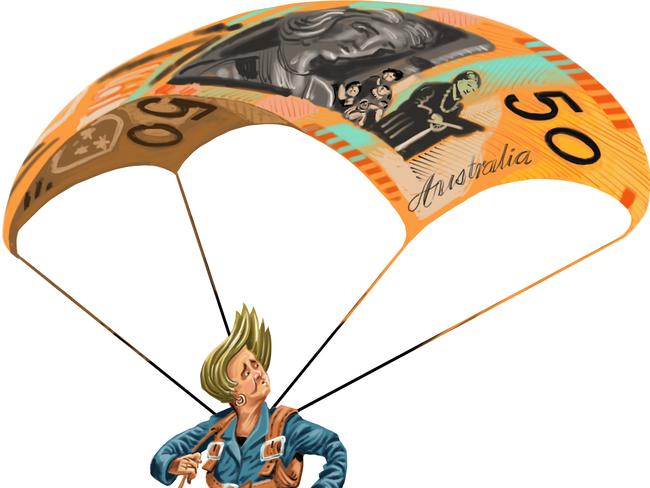Kochie looks at how to build a rainy day fund
AUSTRALIANS are generally hopeless at preparing for financial emergencies. But there are a few simple steps that can make a huge difference.
Saver HQ
Don't miss out on the headlines from Saver HQ. Followed categories will be added to My News.
EVERY year thousands of Australians are victims of natural disasters, which have a devastating effect on the emotional and financial state of so many families.
Then there are those who are blindsided by unexpected retrenchment, long term illness, death of a breadwinner or sexually transmitted debt. On top of that, the car always seems to breakdown or the fridge needs replacing at a time when you can least afford it.
And we haven’t even mentioned economic or financial market crashes.
Life constantly has a habit of throwing curve balls at us that can ramp up the financial strain to breaking point. It simply can’t be avoided.
But implementing a suitable financial emergency plan can cushion any unforeseen blow.
Bottom line is that Australians are generally hopeless at preparing for financial emergencies. So lets start putting that right with a few simple steps which will make a huge difference;
FRESH FINANCE: Put more in your pocket this financial year
REBEL: Disloyalty can save you thousands

PROTECT YOUR BIGGEST ASSETS
Most flood, fire, cyclone and burglary victims are in trouble because they’re either under insured or not insured at all because they didn’t understand the “exclusions” in the fine print.
So today get out all your insurance policies and make sure the house, contents and car are all covered properly. Then check the fine print for the definitions on what is and isn’t covered.
Take a walk around the house and do a quick calculation on how much it would be to replace everything inside … carpets, furniture, appliances, clothes, jewellery … everything. We bet you’ll be stunned at the total amount and how you’re under insured. Fix it quickly.
SAFEGUARD YOUR CASH FLOW
If you are the major breadwinner providing the cash flow to meet commitments, then you must protect that cash flow. That means income protection, life and trauma insurance. Bankruptcy reports show illness as one of the major causes of people becoming insolvent.
The level of personal insurance protection will be determined by your age and level of financial commitments.
BRING DEBT DOWN TO A MANAGEABLE LEVEL
A lot of people get in to strife because they simply borrow too much when interest rates are low (and money is cheap) but then get caught by a double whammy when rates rise and an emergency comes up.
First of all, pay off your most expensive debt like credit cards and store financing. Then start working on the rest.
SAVE SUPERANNUATION EARLY
Retirement should be the best time of your life. It shouldn’t be a time of financial uncertainty and lifestyle sacrifices. The problem is only 20 per cent of people retire when they planned. The other 80 per cent are forced to retire, generally earlier than expected, because of retrenchment, illness or some other reason.
That causes a financial emergency because most people retire on less than what they expected.
Superannuation contributions attract terrific tax benefits so take advantage of them. Work out an amount which will support a good retirement lifestyle and then start contributing as early as you can so that goal is reached well ahead of when you plan to cash in. Just make sure you are in a good superannuation fund which matches your risk profile.
BUILD AN EMERGENCY 6 MONTHS SALARY STASH
That emergency stash could be kept in a bank account but also could be paid off a home loan and easily drawn down when necessary. That way the money can be saving interest and cutting down the term of the loan … just make sure the home loan allows for an easy drawdown even after loss of a job.
It will be hard for most people to come up with an emergency stash straight away so make it a project over the next year.
STRATEGIES TO BUILD AN EMERGENCY FUND
-Use unexpected windfalls
Have a plan where any unexpected cash inflows go straight into the fund. Everything from tax refunds and wages rises to work bonuses and birthday money from relatives.
-Automatic debit on payday
Organise for a fixed amount to be automatically transferred to a separate emergency account on the day your salary hits the bank. It becomes one of those unseen transactions which don’t even register on your radar and you live on what’s left over.
-Target a luxury you can do without
Some estimates indicate that each household wastes at least 10% of its income each month. Look for the money leaks in your budget, such as subscriptions you don’t need anymore, those lazy takeaway Uber-eats deliveries, the unnecessary extra. Plug them, and then use that money to build up your emergency fund.
-Pad your account with dividend earnings.
Build a share portfolio of good dividend stocks and deposit those dividends in your emergency fund. That way you’re building a nice investment nest egg and injecting cash into the emergency fund.
-Collect spare change.
Have your entire family empty the change from their pockets, perhaps including their $1 and $2 coins (maybe $5 notes as well), into a jar at the end of each day. This works especially well if you use mostly cash. At the end of each month, take the money in the jar and add it to your emergency fund.
